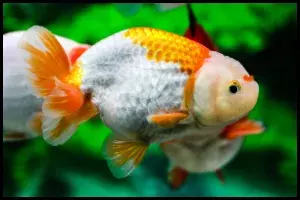
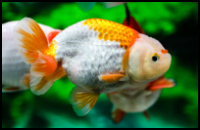
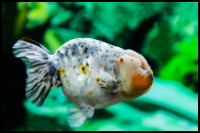
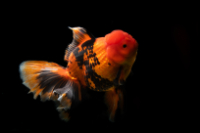
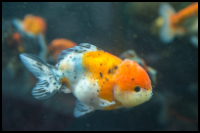
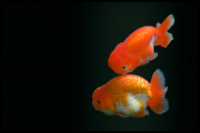
Quick Care Details (Table)
| Livestock Characteristics | Value |
|---|---|
| Care Level | Moderate |
| Temperament | Peaceful |
| Diet | Omnivore |
| Maximum Size | 8 Inches |
| Minimum Tank Size | 25 Gallons |
| Plant Safe | Sometimes |
| Temperature Range | 65-72F |
| PH Range | 6.0 - 8.0 |
| KH Range | 50-120ppm |
| GH Range | 100-300ppm |
Species Specific Categories
Helpful Video
Care Details
- Ranchu prefers a longer tank than a taller tank size. The taller the tank is the more water pressure would be applied to the fish at the bottom of the aquarium.
- Water heaters are optional because goldfish are cold freshwater fish and can thrive in temperatures as low as sixty five degrees Fahrenheit
- Ranchu Goldfish produce a lot of physical waste. Be sure to have a lot of mechanical and biological filtration.
- These goldfish do not need plants or aquarium decorations. This fight might harm them self on any plastic decorations or hardscape.
- No substrate is acceptable and will make care for the goldfish tank easier to clean. If you use gravel, you might run the risk of the goldfish eating the gravel thinking it is food which might cause issues.
- Low water flow is recommended. They are not strong swimmers and can’t fight water flow very well in your tank.
- Low level lights are recommended. You can get away with no lights and just let your room’s lights overcast the tank.
- These are social fish and should be kept with at least two of their own kind in the same tank.
- You can keep these goldfish with other freshwater fish types but make sure they are not aggressive or too fast. They have no way to defend them self’s and are easy to outcompete for food.
- These fish are prone to infections externally and internally. Bloat is common for a goldfish to get. Sometimes these fish will also feed at the surface and gulp down some air with their food which could contribute to bloat.
- These goldfish are also prone to freshwater aquarium pests like anchor worms and other types of pest like fish lice.
Temperament and Behavior
- Ranchu are extremely peaceful fish.
- Can be kept in a freshwater community tank but must be with non-aggressive fish and other slow-moving fish.
- Ranchu are social fish and very much appreciate to have at least one other fish of its type in the aquarium.
- The fish cannot be kept with small fish or invertebrates. If it can fit in their mouth and catch it, they will eat it.
- Must not be keep with fish that will nip at it's fins since it will be unable to defend it's self.
- the growth of this fish will depend on the size of the tank and the size of their food portions. Feed more and give more swimming tank space, they will grow.
Diet and Nutrition
- Their diet can consist of eating any food pellets or flakes on the market.
- They will eat algae wafers or blanched vegetable food as part of their daily diet to maintain a healthy fish.
- They see your plants as food, it just depends on the type of plant. These goldfish will eat your Duckweed as a food source which many aquarists appreciate.
- They will sift through your substrate looking for food. Ranchu will put it in their mouth and then spit it out once they see it is not food.
- Ranchu will eat your hair algae as a part of their daily food intake which is a huge benefit for your aquarium.
- Vegetables your goldfish can eat are peas, lettuce, cucumber, broccoli, baby marrow, cauliflower, and apples food items. Insure the food is the appropriate size to avoid the goldfish from choking.
Tank Parameters
- Ideally, the water temperature in your aquarium should be kept between 65°F and 75°F (18°C to 24°C). Avoid sudden fluctuations in temperature in your tank.
- High-quality filtration is crucial for maintaining good water quality for proper care of your goldfish.
- a tank size of at least 25 Gallons is recommended, but you should really consider a 30 gallon tank size if you are keeping more than one goldfish.
- The ideal pH range is between 7.0 and 8.0 (Potential of Hydrogen)
- Ideal hardness of 5 to 20 dGH (General Hardness)
- High aquarium oxygenation is needed for these active fish because their swim pattern uses a lot of energy.
- Ammonia and Nitrite should always be at zero in your tank.
- Nitrate ideally should be less than 40ppm but might be able to handle more in your aquarium.
History, Popularity, History and Species Variety Details
History and Origin of Ranchu
The Ranchu Goldfish, also known as the Buffalo-head goldfish, has a rich history that spans several centuries and is deeply rooted in East Asian culture. It originated in China during the Tang Dynasty, where it was initially developed from wild carp. These early goldfish were selectively bred for their vibrant colors and unique body shapes. However, it was in Japan during the Edo period that the Ranchu truly flourished. Japanese breeders took great interest in refining and perfecting the Ranchu's characteristics through selective breeding. They aimed to create a fish with a distinct appearance that embodied grace and elegance. During this time, the Ranchu underwent significant transformations. Breeders focused on developing a high, curved back and a deep, round body. The head growth, called a "wen" or hood, became a defining feature of the Ranchu. The wen starts developing at around six months of age and continues to grow throughout the fish's life, adding to its unique charm. The Ranchu's transformation in Japan was heavily influenced by the traditional art of appreciating goldfish types known as "Ranchu Suiei." This art form involved observing and appreciating goldfish from various angles and perspectives to judge their beauty and overall aesthetic appeal. The Ranchu became a popular subject of admiration among artists, poets, and scholars, further cementing its significance in Japanese culture.
Ranchu Popularity
Over the centuries, the Ranchu Goldfish has amassed a devoted following around the globe. Its charm as a pet lies in its distinctive features, including its graceful swimming style, adorable chubby body, and the prominent head growth that sets it apart from other goldfish breeds. Ranchus come in various vibrant colors, such as red, white, black, yellow, and even calico patterns, adding to their allure. These eye-catching fish have become highly sought after among goldfish enthusiasts and aquarists who appreciate their beauty and elegant presence. Ranchus have become popular not only as show fish but also as delightful companions in home freshwater aquariums, where their captivating appearance brings joy and tranquility to observers.
Types of Ranchu
- Traditional Ranchu: These types is the classic and original type of Ranchu goldfish with a rounded body, prominent wen (head growth), and a hump on the back.
- Top-View Ranchu: This variety of Ranchu is judged primarily on the view from the top, focusing on the curvature of the back and the shape of the tail and fins.
- Side-View Ranchu: The Side-View Ranchu is evaluated based on its side profile, emphasizing the curvature of the head, back, and tail.
- Buffalo Head Ranchu: This type has a particularly large and well-developed wen, which covers the entire head and resembles the head of a buffalo.
- Sabao Ranchu: The Sabao Ranchu has a nacreous, or pearl-like, scale appearance. The body may have a pearly, metallic sheen.
- Shuangwen Ranchu: The Shuangwen Ranchu has a double wen, with two distinct head growths.
- Ribbontail Ranchu: These types has a long, flowing tail that resembles a ribbon.
- Lionhead Ranchu: The Lionhead Ranchu has a more rounded head growth resembling a lion's mane.
The Gender of The Goldfish
- Observe the shape of the body: Male Ranchu goldfish often have a slimmer and more streamlined male body shape compared to females. Females body tend to be rounder and fuller-bodied, especially when they are carrying eggs (gravid).
- Look for breeding tubercles: Breeding tubercles are small white or white-tipped bumps that appear on the gill covers and pectoral fins of male Ranchu goldfish during the breeding season. These tubercles are used to stimulate the female during the mating process and are not usually present in a ranchu female.
- Check for a concave vent: The vent is the area just in front of the anal fin, between the pectoral fins. In mature male Ranchu goldfish, the vent may appear concave, whereas in females, it is more rounded and slightly swollen when they are carrying eggs.
- Observe behavior during breeding season: During the breeding season, males may exhibit chasing behavior, trying to corral and impress the females. Females may appear more bloated and may show signs of spawning behavior, like rubbing against objects or plants to release eggs.
- Patience and time: Determining the gender of a Ranchu goldfish might require patience, as some characteristics become more evident as they mature. If your goldfish is still young, it may be challenging to accurately determine its gender.
Breeding Goldfish
- Preparing the Breeding Environment
- Select a spacious breeding tank or pond with clean, well-maintained freshwater. Ensure that the water parameters are suitable for goldfish, including a temperature between 20-24°C (68-75°F) and pH level around 7.
- Provide hiding places, such as plants or artificial structures, where the fish can deposit their eggs and protect them from being eaten by adult fish.
- Offer a larger tank size you are attempting a harem of females.
- Selecting Breeding Pairs
- Choose healthy and mature Ranchu Goldfish for breeding. Ideally, they should be around 2-3 years old.
- Look for fish with desirable traits, including a high, curved back, round body shape, and a well-developed head growth or wen.
- Consider the fish's coloration and markings based on your breeding goals.
- Conditioning the Breeding Pairs
- Separate male and female goldfish into individual care tanks or ponds and provide them with a varied and nutritious diet to improve their overall health and fertility.
- Feed them high-quality, protein-rich foods such as live or frozen brine shrimp, bloodworms, daphnia, or specially formulated commercial foods. This helps enhance their reproductive capabilities.
- Stimulating Breeding Behavior
- Introduce the male and female Ranchus into the breeding tank or pond simultaneously.
- Observe their behavior for signs of courtship, such as chasing, nudging, or displaying vibrant colors. These actions indicate that the fish are ready to spawn.
- Monitor the female's belly for signs of fullness, as it indicates the presence of mature eggs.
- Spawning and Egg Collection
- Once the female is ready to spawn, she will release her eggs while the male simultaneously releases his milt to fertilize them.
- Provide ample hiding places, such as spawning mops or fine-leaved plants, where the eggs can be deposited and protected.
- After spawning, carefully remove the adults from the breeding tank or pond to prevent them from consuming the eggs.
- Rearing the Fry
- After a few days, the fertilized eggs will hatch into tiny Ranchu fry. They will initially attach themselves to surfaces such as the spawning mops or plants.
- Once the fry become free-swimming, provide them with small, nutritious food such as baby brine shrimp, crushed flakes, or commercial fry food.
- Maintain clean water conditions, performing regular water changes to ensure the fry's health and growth.
- Separate and cull the fry based on their development and adherence to breed standards, allowing only the most promising individuals to grow further.
Frequently Asked Questions
Are Ranchu goldfish suitable for outdoor ponds?
Ranchu goldfish can be kept in outdoor ponds, provided that the pond is adequately sized, properly filtered, and protected from predators. They should be gradually acclimated to outdoor conditions to prevent temperature shock.
How do I care for the wen (head growth) of a Ranchu goldfish?
The wen of a Ranchu goldfish is a delicate area that requires proper care. Ensure good water quality to prevent infections or growth deformities. Regularly monitor the wen for any signs of redness, irritation, or excessive growth. Gentle cleaning and occasional trimming may be necessary to maintain the wen's health and appearance.
Can Ranchu goldfish be kept with other fish?
Ranchu goldfish can be kept with other peaceful, slow-swimming goldfish varieties in a suitable tank. Avoid keeping them with fast-swimming or aggressive fish that may outcompete them for food or cause stress.
Are Ranchu goldfish prone to any health issues?
Ranchu goldfish, like other fancy goldfish, are prone to certain health issues such as swim bladder problems, bacterial infections, and issues related to their wen. Maintaining good water quality, providing a balanced diet, and regular observation can help prevent or address these health concerns.
Do Ranchu goldfish require a specific water flow in the tank?
Ranchu goldfish prefer gentle water flow in their tank. Strong currents can stress them and hinder their swimming ability. Adjusting the filtration and positioning the water outlets in a way that creates minimal disturbance is ideal.
How long do Ranchu goldfish live?
With proper care, Ranchu goldfish have the potential to live for 10 to 15 years or even longer. Providing them with a suitable environment, good nutrition, and proper maintenance can contribute to their longevity.
Do Ranchu goldfish require a specific water flow in the tank?
Ranchu goldfish prefer gentle water flow in their tank. Strong currents can stress them and hinder their swimming ability. Adjusting the filtration and positioning the water outlets in a way that creates minimal disturbance is ideal.
Can Ranchu goldfish live in a bowl or small tank?
Ranchu goldfish require a tank that provides enough space for swimming and growth. Keeping them in a bowl or small tank is not suitable as it restricts their movement and can lead to poor water quality. A tank of at least 25 gallons (95 liters) is recommended for a single Ranchu, with larger tanks preferred for better comfort and water quality.
Can I keep a Ranchu goldfish alone in an aquarium?
Yes, but they are social fish. They enjoy the company of another Ranchu goldfish. You can quarantine them individually but for long term they should have a friend.
can ranchu goldfish live an brackish water?
Ranchu goldfish are freshwater fish and are not naturally found in brackish water environments. They are a variety of fancy goldfish that originated in Japan and have been selectively bred for their unique features. As with most fancy goldfish, they are best suited for freshwater aquariums with stable water conditions.

